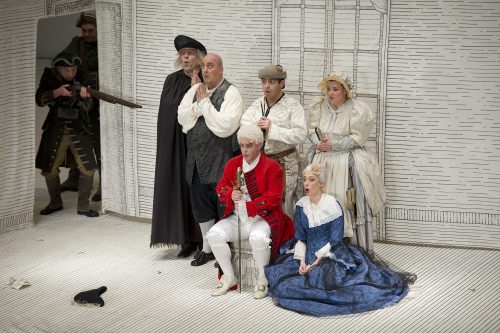 United Kingdom Rossini, Il barbiere di Siviglia: Soloists, Staatsopernchor Berlin, Staatskapelle Berlin / Ido Arad (conductor). Staatsoper Unter den Linden, Berlin, 16.2.2024. (MB)
United Kingdom Rossini, Il barbiere di Siviglia: Soloists, Staatsopernchor Berlin, Staatskapelle Berlin / Ido Arad (conductor). Staatsoper Unter den Linden, Berlin, 16.2.2024. (MB)

Production:
Director – Ruth Berghaus
Revival director – Katharina Lang
Designs – Achim Freyer
Chorus director – Dani Juris
Cast:
Count Almaviva – Siyabonga Maqungo
Doctor Bartolo – Renato Girolami
Rosina – Marina Viotti
Don Basilio – Grigory Shkarupa
Berta – Adriane Queiroz
Figaro – Samuel Hasselhorn
Fiorillo – Dionysios Averginos
Ambrosio / Notary – Florian Eckhardt
Officer – Wolfgang Biebuyck
I see that, in London, Jonathan Miller’s 1987 ENO production of The Barber of Seville is receiving another outing. It seems positively modern, though, at least when it comes to years and performances on the clock, when compared with Ruth Berghaus’s 1968 staging for the Staatsoper Unter den Linden, first seen a little less than midway between the declaration of the German Democratic Republic and the fall of the Berlin Wall and now past 350 outings. In one of these near-miracles impossible fully to explain, though, Berghaus’s production seems more of our time – I cannot quite bring myself to describe anything, anti-historically, as ‘timeless’ – than many a staging receiving its premiere. It is probably the oldest I have ever seen in the theatre, yet it does not seem like it. Doubtless it has changed over the years; the director who dared to make changes at the Berliner Ensemble, would hardly have wished it otherwise. Some gestures struck me as highly unlikely to have been hers. Still more than usually, then, to speak of ‘Berghaus’s production’ will be a short-hand for a collaborative, changing effort. By the same token, it is difficult to believe that, at its heart, this is not something true, through fidelity and infidelity alike, to her conception. Above all, it provided the foundation on which a delightful evening of Rossini’s comedy unfolded.

At that heart, I think, is a crucial insight not only into the artificiality of theatre – though that is certainly present – but into the very particular artifice involved in that arch-formalist Rossini. In a passage extracted in the programme, Berghaus exclaims (my translation): ‘Reality! Theatre is not reality and does not mirror reality. Theatre asserts a life that is taken from reality. But it is not reality. One must accept theatre as an addition to reality. It is a stage that does not mean the world. … The theatre is an institution that makes it possible to come to terms with reality.’ That is what we see here, not only in outcome but in construction too. Returning, via Brecht yet only in part, to the commedia dell’arte, beautifully evoked by the young Achim Freyer – then in his mid-thirties, this year celebrating his ninetieth birthday – the production simply builds its sets before our eyes and ears. Curtains, a few props, and an eye for design are all that is needed for a ‘Seville’ that is neither a naturalistic presentation nor a provocative anti-Seville to arise as the necessary backdrop for singers to act, to make comedy.
Very well they did so too. Samuel Hasselhorn, as Figaro, emerged as first among equals, unfailingly musical, clean and meaningful in coloratura, and with the timing of a seasoned actor. Marina Viotti’s Rosina similarly excelled, with Siyabonga Maqungo a likeable if, occasionally, a less theatrically tight Almaviva. Grigory Shkarupa constructed a splendidly real-yet-not-real Don Basilio. A sparkling performance from Adriane Queiroz left one wishing Berta had more to sing. What Renato Girolami sometimes lacked in vocal presence; he made up for in theatrical commitment as Doctor Bartolo. The Staatskapelle Berlin, keenly directed throughout by Ido Arad, did not put a foot wrong, evoking, somewhat to my surprise, a sound not so distant from that of Neville Marriner’s vintage Academy of St Martin in the Fields. Bright, precise, and likewise with pinpoint timing, here was another crucial dimension never to be reduced to anything else, yet likewise never approaching abstraction. The aesthetics, then, were as ‘right’ as the execution.
‘The picture,’ Berghaus explained, ‘really only has to enable the singer to act. I am very dependent on good singers, and sometimes I am of the opinion that singers are greater comedians than actors.’ They sing and take their bows, then, neither to depict ‘reality’ nor simply to present a ‘plot’. The relationship is complex, yet it does not feel as though it is. There does not feel as though there is anything to be ‘interpreted’ at all, though that is surely to conceal much work. That, in any case, can be considered afterwards, or before. A world of enjoyment is created, yet one which permits something deeper to speak, to sing, to be felt. By never forgetting that it is theatre, its success continues.
Mark Berry
